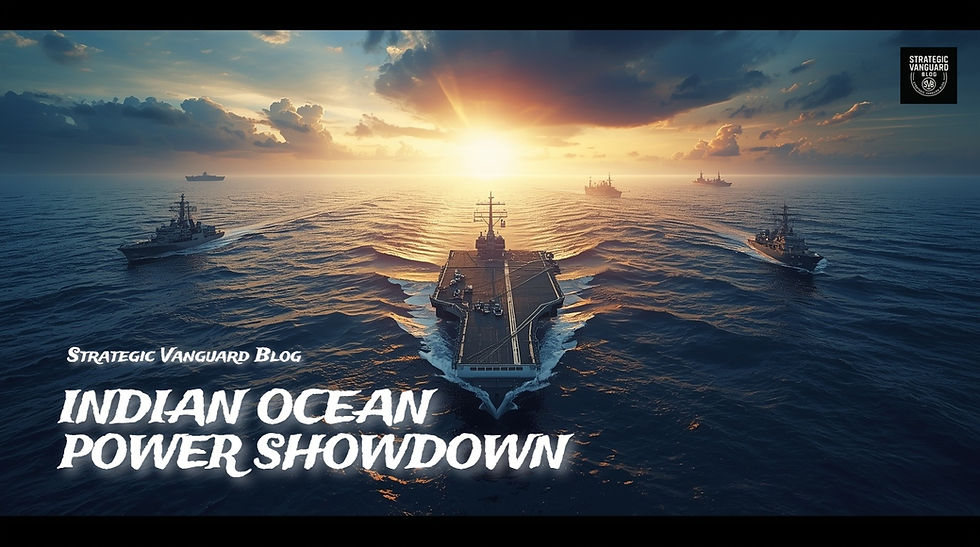From Baby Boomer to Ocean Sentinel: India’s Strategic Submarine Journey (2009–2025)
- Manoj Ambat

- Jul 22
- 3 min read

From Baby Boomer to Silent Sentinel – India’s Nuclear Submarine Force Comes of Age
Today is not just a landmark in the history of the Indian Navy, but a moment of immense pride for the entire nation. As we reflect on the legacy of 26 July — the Kargil Vijay Diwas, marking 26 years since India's decisive victory in the heights of Kargil, we are also reminded of another milestone that changed the trajectory of India’s naval and strategic deterrence capabilities: the formal launch of INS Arihant in 2009.
Fast forward to 2025, INS Arihant has not only proven itself operational but has also paved the way for a fleet of indigenous nuclear-powered ballistic missile submarines (SSBNs) forming the third leg of India’s nuclear triad. From being termed a “Baby Boomer” in 2009 due to its limited size and range, Arihant now stands as a proud progenitor of India’s strategic submarine fleet.
India’s Nuclear Submarine Journey: From One to Many
When INS Arihant was launched in Vishakapatnam’s Ship Building Centre, it marked India’s entry into an exclusive club of nations — the United States, Russia, France, the United Kingdom, and China — that have mastered the art and science of building and operating nuclear-powered submarines capable of launching ballistic missiles. Today, India’s SSBN fleet includes:
INS Arihant (commissioned 2016)
INS Arighat (expected to be commissioned soon)
Two more Arihant-class SSBNs under construction
A new generation SSBN class, larger and more capable, in advanced stages of design and early production
These submarines are not fast attack subs (SSNs), but strategic deterrence platforms — designed not to engage in naval warfare but to remain undetected in deep waters, ready to launch a second strike in case of a nuclear attack on India. Their very existence is a deterrent.
From K-15 to K-4 and Beyond: India’s Missile Arsenal Grows
In 2009, Arihant was equipped with the K-15 ‘Sagarika’ SLBM (Submarine-Launched Ballistic Missile), with a limited range of just 750 km. This meant the sub had to venture dangerously close to adversary shores to pose a credible threat — an obvious risk.
In 2025, that scenario is significantly improved:
K-4 SLBM (3,500–4,000 km range) has entered advanced testing and limited operational use, giving India the ability to strike deep into adversary territory without venturing too close.
The K-5 and K-6 missiles — longer-range and MIRV-capable — are reportedly under development.
Plans are underway for future SSBNs with vertical launch systems capable of carrying heavier missile loads and longer-range ICBMs.
Although still not on par with the American Trident-II D5 (11,000+ km range) missiles deployed on the US Navy's Ohio-class "Boomers," India has leapt forward in its capabilities in just over a decade.
Silent Warhorses of Deterrence: The Strategic Importance
SSBNs like Arihant are the most survivable leg of the nuclear triad. Unlike air or land-based systems that are susceptible to first strikes, these submarines remain hidden in the ocean's depths for months, powered by nuclear reactors, surfacing only when resupply is needed. India’s earlier diesel-electric subs were constrained by battery life, forcing them to surface regularly and risk detection. That vulnerability no longer exists with nuclear propulsion.
The current Arihant-class subs may still be smaller than their Russian Borei-class or American Ohio-class counterparts (Arihant displaces around 6,000–8,000 tons submerged vs 18,000+ tons for the Ohio), but they are true strategic platforms. Their small size gives them stealth, and India's new submarine base, INS Varsha, is tailored to house these silent guardians.
Looking Ahead: Towards a Full-Spectrum Deterrent
India still has a long way to go before matching the SSBN force levels of China or the United States. However, its commitment is clear:
More SSBNs are in the pipeline, including next-generation designs with greater endurance, higher speed, and larger missile payloads.
Indigenous SSN program (nuclear-powered attack submarines) is now being fast-tracked — with at least six SSNs planned.
The Naval Nuclear Reactor programme has matured, offering not just military applications but energy and industrial spinoffs.
India’s acquisition of the INS Chakra (formerly Nerpa) from Russia in the past, and its experience with Arihant-class construction, has created a generation of trained Indian submariners and engineers who are building a future fleet — not just operating one.
Conclusion: A Promising Start, A Strategic Future
From the ceremonial launch of INS Arihant in 2009 to a growing SSBN fleet in 2025, India has come a long way. While the term “Baby Boomer” once described Arihant’s modest size, today, the Indian Navy’s nuclear submarine program has matured into a formidable leg of national defense.
As we commemorate Kargil Vijay Diwas, we are reminded that the true guardians of India’s sovereignty are not just on the mountains or in the skies — they also sail silently beneath the waves, unseen but ever-ready.



Comments